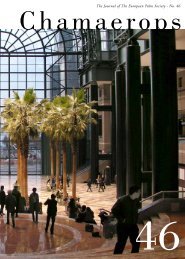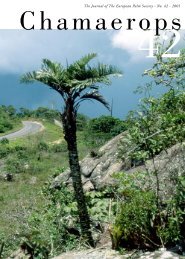Conservation throughCultivationby Andrew CartwrightI sometimes despair about the destruction ofour Earth's beauty. Every year many differentkinds of animals and plants become extinct. <strong>The</strong>ywill never be seen again. For many years I feltthat all I could do to remedy this awful situationwas to support the work of organizationsconcerned with conservation; but recently, I havebegun to think that I may be able to play a moredirect role in conservation.Out of a total of about 2,750 species of palm,nearly a third are threatened with extinction inthe wild (source: "1997 IUCN Red List ofThreatened Plants" compiled by the WorldConservation Monitoring Centre). Conservationof palms in the wild is largely dependent uponprotection of the habitats in which most of thesepalms live. Despite the magnificent efforts ofseveral organizations, such as Greenpeace, whoare working hard to protect these habitats, thescale of the problem appears to be so large that itseems unlikely that these projects alone will besufficient to prevent many species of palm fromdisappearing.A few of the threatened species are wellestablished in cultivation, and, althoughcultivation is not an ideal substitute for preservinga species in the wild, it is surely better than losingthe species entirely. Unfortunately, many of thosespecies threatened with extinction in the wild arerare, or even non-existent, in cultivation.Whilst this is a gloomy picture, there doesseem to be a precaution that we can take, ratherlike taking out an insurance policy. My reasonfor writing is to ask the membership what theythink of my proposal. It is possible to purchaseplants or seeds of some of those palms that areboth threatened with extinction in the wild andrare in cultivation. My hope is that by raisingand caring for some of these, we, as amateurgrowers, may be able to help preserve them forfuture generations. Our action may not help tosafeguard them from destruction in the wild, but,providing we buy from reputable sources, neitherwill we hasten their destruction.Although conservation by amateur growersmay not seem to be an ideal approach to theproblem of saving palms from extinction, it doesseem to be a way in which some species, whichwill probably become extinct in the wild, mightbe saved for future generations. Certainly, if aspecies is destroyed in the wild, every plant ofthat species which survives in the collections ofamateurs will become more precious.Unfortunately, the fact that a species is keptin botanical gardens is not sufficient to guaranteeits survival. Genetic variety is important for thesurvival of a species because plants that aregenetically identical are likely to be vulnerableto the same pests and diseases. It seems thatvariety is more likely to be maintained if thespecies is kept not only in botanical gardens butalso in numerous small populations belonging toamateur growers. Also, there is a possibility thata species may become extinct and then, at a laterdate, an attempt may be made to reintroduce itinto the wild. Successful reintroduction seemsmore likely if greater numbers of the species areavailable, and, once again, small populations keptby amateur growers may prove invaluable.page 8
I do not know of an example of a palm thathas been reintroduced to the wild; instead, Iwould like to refer readers to an article about abird. See Tony Juniper's "Plan to bring Spix'smacaw back from the brink" in BBC Wildlifemagazine, October 2000. In 1990 there were onlytwelve Spix's macaws left - one in the wild andeleven in captivity. Since then a concerted efforthas been made to conserve this species and anumber have been bred. <strong>The</strong> first tentative stepshave been taken to introduce captive birds intothe wild, where, amazingly, the single birdremaining in 1990 has survived. <strong>The</strong> project hasnot yet succeeded, and may never do so, but itdoes illustrate the possible importance that palmskept in cultivation might have if their speciesbecomes extinct, or nearly so, in the wild.Conservation is a considerable challenge foran amateur grower. Pessimists quote a long listof problems facing the amateur grower, but Ithink it is wrong to allow pessimists to discourageus. Whilst it is true that an amateur grower willexperience many problems, this is true of anyworthwhile project, whether it be concerned withconservation of palms or anything else. Of course,the possibility of solving problems is an attractionfor anyone with a positive outlook.If, as enthusiasts, we can make a success ofcreating numerous small populations ofthreatened palms, then we might be able toencourage the wider public to participate. Everyyear, millions of people buy plants for their homeor garden, including a few species of palms ofwhich thousands are bought every year. Manygardeners raise plants from seed, though rarelypalms. Most of this vast expenditure goes towardsplants that are not threatened with extinction. Ifjust a small amount of this expenditure could bediverted into caring for threatened palms, thenthis would further increase the chances of thosespecies surviving. Of course, the principle couldbe extended to other types of plants, and for somesuggestions as to which species might be suitableI refer the reader to "Trees in trouble: a newcampaign to save world's rarest species," a sixteenpage booklet issued free with the abovementioned magazine.If the members think my proposal is worthpursuing, then I would be willing to devote someof my time to compiling a database of amateurgrowers and the threatened species of palm whichthey hold, and which they would one day bewilling to donate to a conservation programshould the need arise.For myself, when I buy palms in the future, Iwill be buying those threatened species that Ibelieve I can successfully look after, and for whichI can provide the conditions required by thespecies for reproduction. Although I am no expertI have drawn up a list of a few palms which seemsuitable for cultivation in a cool temperate climatesuch as our own, or for cultivation indoors, andI would be very interested to have members'comments on the list. I have examples of two: aChamaedorea glaucifolia, nearly 5ft tall, growingslowly but surely in my living room at atemperature of 70-80°F (21-27°C) and humidityof 65-75%. Excepting for midwinter, this plantgrows all year round. I also have a newlygerminated seedling of Dypsis decipiens.Brahea aculeata (Aculeata palm, SinaloaHesper <strong>Palm</strong>): B. aculeata will grow in a shelteredgarden in a cool temperate climate. It needs fullsun and well-drained soil. It is also suitable foruse indoors in a brightly-lit position. Single plantsare capable of producing fertile seeds. Height: 5m(15ft) Width: 2.5m (8ft). Conservation status:vulnerable.Brahea decumbens (Sierra Madre <strong>Palm</strong>): <strong>The</strong>leaves of B. decumbens are amongst the bluestfound on any palm. It has a decumbent(underground) trunk and is slow growing. Itsnatural habitat is on exposed hills (in Mexico) soit may be suited to a cool temperate climatealthough this has not been proven. Indoors, itrequires full sun, well-drained soil, and it maybenefit from the addition of lime to the soil.Single plants are capable of producing fertileseeds. Height: 3m (10ft) Width: 2.5m (8ft).Conservation status: vulnerable.page 9










